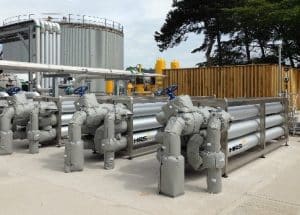Article by HRS Heat Exchangers

Anaerobic digestion (AD) is a well-established technique for the production of renewable energy (biogas) and the management of organic wastes such as sewage sludge, manures and crop wastes. It is also capable of producing a sustainable biological fertiliser in the form of digestate. However, although the technique is well developed, many digester designs still incorporate heating elements within the tank itself (or in the floor or the walls), an outdated design which causes a number of operational difficulties and can lead to unnecessary and expensive downtime.
Anaerobic digestion is a naturally occurring biological process which is dependent on the management of a range of microorganisms. As such temperature control is crucial to maintaining a productive and efficient digester. Anaerobic digesters are normally designed to operate in one of two temperature regimes: mesophilic digestion occurs between 30 °C and 38 °C, with a typical set point of 37 °C, while thermophilic digestion occurs at 50 °C to 57 °C with a set point of 55 °C. There are pros and cons to each approach, and the type of digester use will depend on a number of factors including the feedstock to be treated, the availability of heat and energy, and the type of technology used in the design of the plant. Thermophilic digestion is quicker but has a higher energy requirement and is more common in larger AD plants, while mesophilic plants have a lower energy requirement but a longer processing time; as a result, they are more common in smaller installations and for sludge treatment.
Several types of bacteria are involved in the anaerobic digestion process, and different temperature regimes will suit different bacteria. First-stage bacteria break down carbohydrates during bacterial hydrolysis to produce soluble materials such as sugars and amino acids that are then consumed by acidogenic bacteria which convert them into carbon dioxide, hydrogen, ammonia, and miscellaneous organic acids. These substances are then converted into acetic acid, which is converted by archaea bacteria into methane and carbon dioxide (biogas). The remaining digestate consists of a mixture of water, minerals, and residual organic carbon, which can be used as high-quality fertiliser.
Irrespective of which temperature regime is utilised, in many situations some form of digester heating will be required, with even mesophilic plants needing some additional heating in colder conditions. Without this additional heat biogas yields will be below optimum, but from an operational perspective, it is important to consider the thermal energy input required in relation to the energy potential of the biogas produced in order to determine the economic (and environmental) optimum. A biogas plant which consumes more energy than it produces may work from a waste treatment perspective but will generate positive carbon emissions and be economically unviable.
In theory the digestate can be heated directly (by injecting steam or hot water into the digestate) or indirectly (using heat exchangers or heating elements), but in practice the disadvantages of direct heating, such as continual dilution of the digestate, mean that it is seldom employed.
In the past the heating system (often comprised of a number of hot water pipes) has been located on or around the floor of the main digester. While this results in good initial heat transfer and creates thermal currents in the digestate to assist mixing, the accumulation of sediment quickly diminishes these properties and regular cleaning (which requires the digester to be emptied each time) is necessary to maintain satisfactory performance with such systems. In some cases, heating units have actually been incorporated into the concrete walls or floor of digesters adding to the potential problems and expense should something go wrong.
The solution is to locate the heating unit outside of the digester, an approach which is not new. In fact, one of the earliest uses of an external heater and heat exchanger for a digester in a wastewater setting occurred in Urbana, Illinois in 1946 when the Urbana and Champaign Sanitary District installed an external unit manufactured by the Pacific Flush Tank Company to overcome the recognised disadvantages associated with unexpectedly emptying digesters in order to repair or clean internal heating coils1.

Since then, external digester heating based on heat exchangers has been used successfully in AD plants around the world. Over the years the design of heat exchangers has improved considerable and is epitomised by the HRS DTI Series of corrugated tube heat exchangers which are ideally suited for the external heating of digester fluids and sludge – and which have been successfully used in a number of such applications.
The biggest advantage of external heating is that it can be checked, cleaned or serviced at any time without the need to empty (or enter) the digester, a process that is both costly and potentially dangerous. However, there are a number of other benefits, including the fact that external systems can be designed so that one heat exchanger array heats more than one digester, and that the improved thermal performance reduces heating requirements and improves the overall energy efficiency of the AD plant. Where units are constructed of materials such as stainless steel, operating life is considerably improved compared to internal heating units, and routine maintenance is straightforward.
The HRS DTI Series is a true counter-current heat exchanger, meaning that the product flows through the inner tube and the service fluid flows through the surrounding shell. HRS’s corrugation technology increases both heat transfer and efficiency over standard smooth tube heat exchanger designs and minimises fouling, and important consideration when dealing with materials such as digester sludge. Multiple units can be interconnected and have the options of frame mounting, insulated and cladded in stainless steel.
To discover why a number of AD plants are replacing their original internal heating systems with external heating using DTI Series heat exchangers, please talk to us today.





